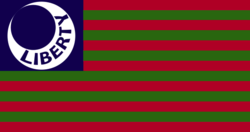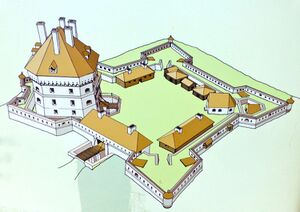Liberty: Difference between revisions
| Line 67: | Line 67: | ||
==Demographics== | ==Demographics== | ||
The country has a total population of 1,002,449 citizens. | |||
The following was the ethnic breakdown of the country, according to the 1691 census: | |||
*Amorians: 558,991 | |||
*Colish: 304,179 | |||
*Senyans: 98,157 | |||
*Indigenous: 29,119 | |||
*Other: 12,003 | |||
==Economy== | ==Economy== | ||
Revision as of 13:08, 22 August 2021
 | |
| Official language | English |
|---|---|
| Capital | Liberty |
| Largest cities | Liberty |
| Date founded | 1676 AN |
| Government | Direct Democracy |
| Current leader | President Theodore Riverton |
 | |
The Country of Liberty, or more frequently Liberty, is a democratic state located in northwestern Keltia. It began its existence as the communist state known as Col, an acronym for its longer current name. The original Col was destroyed and refunded several times, culminating in the establishment of a new city on the shores of Red Lake, built on the ruins of Old Colgrad and called Liberty. This New Democratic state was founded by Amorians fleeing the civil war in Jingdao who wished to establish a new nation that enshrined the virtues of true democratic principles.
History
USSC
Liberty began its life as the United Soviet States of Col, a communist nation founded on the shores of Red Lake and one of the earliest members of the CIS. Carried in on the waves of migratory peoples by the advent of Lovely, which occupied much of the northern half of Apollonia. The communist state flourished for some centuries, even colonizing the nearby island of Ertia in Red Lake, before its eventual decline and collapse. The area was then fought over by various foreign powers who further decimated the local population. Eventually the region was abandoned altogether, with Liberty becoming little more than a fading memory.
Founding
The present Country of Liberty began far to the west in Senya when a group of Amorians living near Fort Kolgrad - themselves descendants of Colish expatriates - became caught in the skirmishes with the ongoing civil war in neighboring Jingdao. The incessant border raids by roving bands of Jingdaoese warlords had made life for the Amorians miserable. These discontent civilians began to form close-knit communities for self-defense and mutual support. They became known as the Green Rangers, and formed their own militia to help defend the local homesteads. But as these militia went against Senyan law, they found themselves at odds with both the Jingdaoese and fellow Senyans. As such the the topic of resettlement elsewhere came to the forefront. Benjamin Bradford, a prominent farmer and militiaman, proposed the idea of returning to Col and establishing a new city on the ruins of Old Colgrad. The idea gained traction within the community, and in 1675 AN a group of three-thousand civilians chartered a private ship to ferry them to Keltia. The group had sold most of their belongings, save for bare essentials and supplies needed in the new location, and used the money raised to charter passage. In early spring 1676 Bradford landed near the Dark Berry Islands on the western coast of Keltia. From there he lead his fellow pioneers across the Green to the shores of Red Lake.
Upon arriving at Red Lake the group found the ruins of Old Colgrad to be little more than a pile of stone. The former city had been completely overtaken by Mother Nature. Undeterred, Bradford set about building makeshift shelters as temporary housing while others began clearing the roads of debris and building more permanent residences. By winter of 1676 a small village known as Liberty had taken shape on the ruins of Old Colgrad.
The Libertines
The early inhabitants of Liberty took to calling themselves Libertines. With a small population of only three-to-four thousand people, Bradford was able to arrange a commune-like direct democracy wherein all citizens partook in the governance of the city-state. Public meetings were held one per month at Liberty Hall in the center of the city. Here people were given red and blue flags and asked to vote on various legislative issues; a red flag raised meant no, a blue meant yes. People were organized into blocks wherein tallymen would run around counting votes. The primitive system worked and the city prospered as a bastion of democratic government. As a result, immigrants begin flocking to the region hoping to partake in the new nation.
Bradford, who had assumed leadership simply by virtue of helping establish the colony, started to become overwhelmed by the influx of people. Liberty quickly grew from three-thousand to twelve-thousand by 1680. Now aging and overwhelmed by the burden of a large city, Bradford announces in 1681 that Liberty will hold its first general election and he would step down from office. Rather than the use of flags, which had become onerous with so many people, the provisional government decides to use paper ballots to cast votes. The vote would offer the chance for any legal citizen to run for the office of President of the Republic. This leads to a plethora of candidates, but the frontrunner is a plucky young democrat by the name of Hamilton Jones who cruises to victory in a landslide. Jones, who had migrated two years prior with his wife and family, was well-educated. Within the first year of his presidency he helped to create a number of lasting Libertine institutions.
Among Jones' accomplishments was the construction of Liberty Hall, which was built to house the legislative assembly and presidential offices. He also helped to codify the first Libertine constitution which helped lay out the laws for general elections and governance of the city (then the extent of the colony). His efforts to streamline the processes of direct democracy helped to ensure Liberty would develop as a true republic and not, like so many other nations, slip into a dictatorship in the future.
Westward Ho!
The exponential growth of Liberty soon caused the city to overflow with immigrants. While it transitioned from a rural colonial settlement to a major city there were many who quickly began to itch for more lands outside the suburban environs. In 1683 Jones announced the Western Treaty negotiated with the local indigenous Qeltois tribes. In a pact signed with Chief White Wolf, the tribe granted Liberty a large tract of land to the west which included the ruins of Benkerngrad, another former Colish city. Within mere hours of signing the treaty families began packing up their belongings and heading west. The vacuum created by this mass migration triggered another influx of migrants from outside the country.
Within the western land grant, Jones announced that each family could claim rights to 100 acres of land provided they could turn a profit on the property within five years. This included paying a tax levy that in turn would support the government. The lucrative promise of free land lured many to try their hand farming, and with those farms arose the logistical needs to support them: blacksmiths, taverns, sawmills, gristmills, etc. But not all farms were successful. Many gave up fighting poor soil, diseases or rural isolation, eventually returning east to Liberty City. Nonetheless, the westward population continued to grow. Despite treaties with the Qeltois, other native tribes began raiding the new settlements. The Massacre of Helmswyck, in which 500 settlers were killed, caused the government to reassess the situation. In a meeting at Liberty Hall, Jones announced the construction of Fort Defiance on the ruins of Benkerngard, which would serve as a bastion to defend the western frontier.
Fort Defiance
Fort Defiance would quickly become the epicenter of the Libertine Militia. President Jones, realizing the necessity for creating a standing army to defend the country, decided to use the new fort as the headquarters for the militia. The stone fort quickly began to take shape, with 12-foot thick walls four stories high and with cannons on each level. Six bastions, three of which protect a four-story, eight-sided stone citadel. Watch boxes were located at the tip of each of the four corner bastions. Inside the citadel, cannons were mounted on each floor and the entrance included a ditch and drawbridge. The fort was planned to mount some 62 cannons with about a 100 man garrison. The fort even had its own chapel. The focal point of the fort was the four-story, eight-sided stone citadel that stands as the main bastion.
The fort quickly became a major staging ground for the fledgling Libertine Militia and for settlers traveling west. Even though it was at the far western end of Libertine lands, the fort became an important point of resupply for wagon trains. People migrating from Liberty City to tracts in the west would loop north to resupply after the long trek, then head south towards the land grants. This brought a great deal of wealth and development to Fort Defiance. With all these people passing through the area also grew to house the militia barracks and various training facilities, soldiers' housing, farms to supply food, and so on and so forth. The Great Western Turnpike, as it came to be known, soon formed a major arterial road between Liberty City and Fort Defiance.
Birth of the Republic
In 1687 Hamilton Jones passed away at the ripe old age of 86. Only a year prior Benjamin Bradford had also passed away, himself 96. While not entirely unexpected due to their advanced age, the power vacuum left behind by the loss of these two men shook the young Libertine state to its core. By now the country had grown to a considerable size, far more than the founders had originally envisioned as a small city-state. And up until this time, Libertine citizens had been given relatively free reign, with limited taxation and bureaucracy. But these freedoms came at the price of poor representation, limited government services, and a shoddy infrastructure. Thus in late 1687 a congress was called at Liberty Hall to debate the future of the country, decide policy, and elect a new president.
Geography
Liberty is located on the northern shores of Red Lake on the continent of Keltia.
Government and Politics
Culture
Demographics
The country has a total population of 1,002,449 citizens.
The following was the ethnic breakdown of the country, according to the 1691 census:
- Amorians: 558,991
- Colish: 304,179
- Senyans: 98,157
- Indigenous: 29,119
- Other: 12,003
Economy
Infrastructure
Liberty's infrastructure is primarily agrarian with some shipbuilding located along Red Lake. But since Liberty has no direct access to the sea, all ships have to pass through the Hexarchy. Thus most ships are sold to people living along the lake or within the Hexarchy itself. Most other industries are self-sustaining. Meaning that goods produced are not exported but are instead directly utilized by the residents of those immediate areas.
